steering VAUXHALL ZAFIRA 2014 Owner's Manual
[x] Cancel search | Manufacturer: VAUXHALL, Model Year: 2014, Model line: ZAFIRA, Model: VAUXHALL ZAFIRA 2014Pages: 217, PDF Size: 7.85 MB
Page 9 of 217
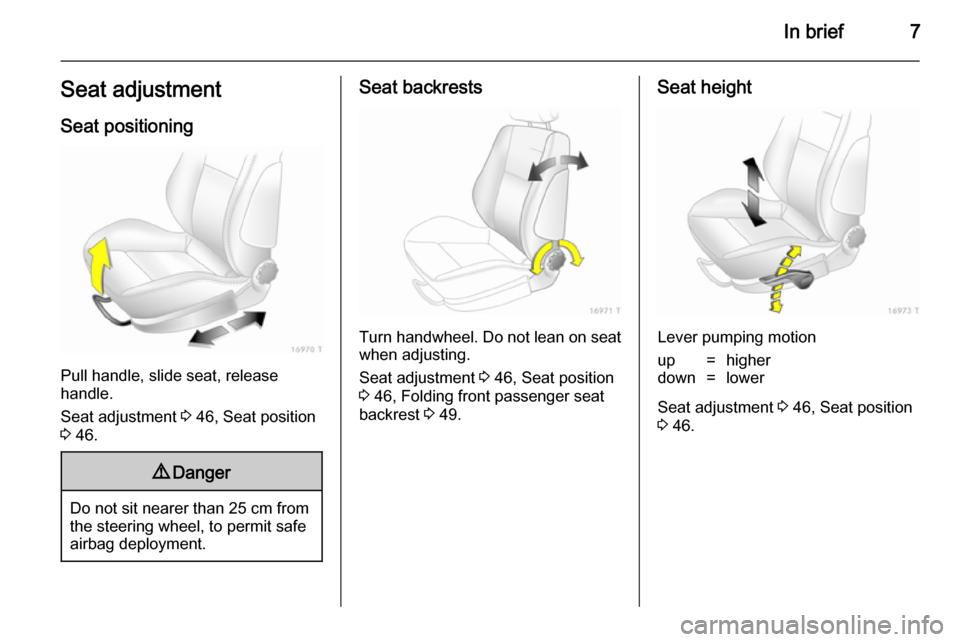
In brief7Seat adjustmentSeat positioning
Pull handle, slide seat, release
handle.
Seat adjustment 3 46, Seat position
3 46.
9 Danger
Do not sit nearer than 25 cm from
the steering wheel, to permit safe
airbag deployment.
Seat backrests
Turn handwheel. Do not lean on seat when adjusting.
Seat adjustment 3 46, Seat position
3 46, Folding front passenger seat
backrest 3 49.
Seat height
Lever pumping motion
up=higherdown=lower
Seat adjustment 3 46, Seat position
3 46.
Page 11 of 217
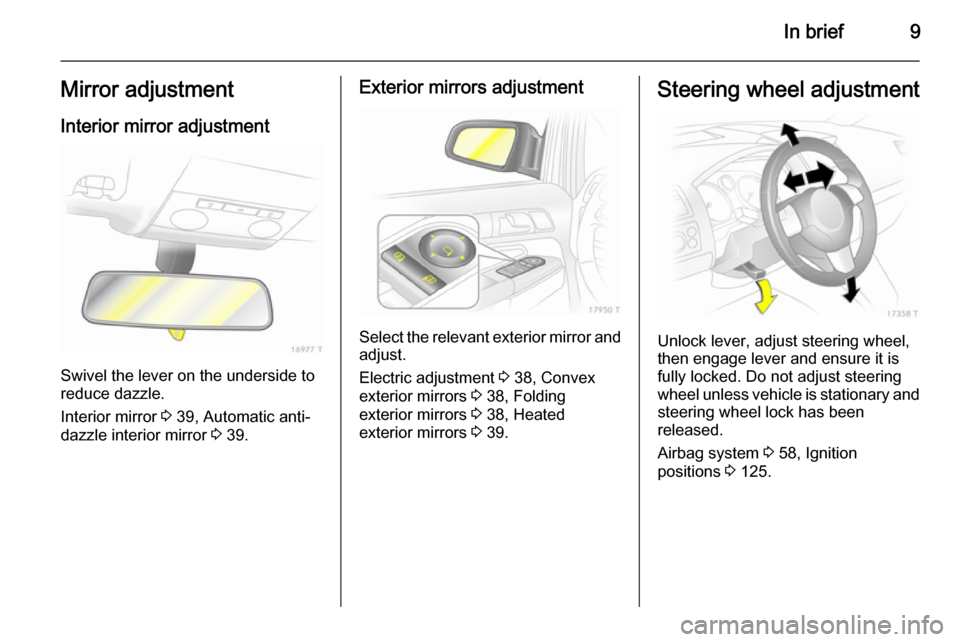
In brief9Mirror adjustment
Interior mirror adjustment
Swivel the lever on the underside to
reduce dazzle.
Interior mirror 3 39, Automatic anti-
dazzle interior mirror 3 39.
Exterior mirrors adjustment
Select the relevant exterior mirror and
adjust.
Electric adjustment 3 38, Convex
exterior mirrors 3 38, Folding
exterior mirrors 3 38, Heated
exterior mirrors 3 39.
Steering wheel adjustment
Unlock lever, adjust steering wheel,
then engage lever and ensure it is fully locked. Do not adjust steering
wheel unless vehicle is stationary and steering wheel lock has been
released.
Airbag system 3 58, Ignition
positions 3 125.
Page 13 of 217

In brief11
1Light switch ........................ 108
Instrument illumination .......113
Rear fog light ....................... 112
Front fog lights ...................111
Headlight range
adjustment ......................... 109
2 Side air vents ...................... 122
3 Turn and lane-change
signals, headlight flash,
low beam and high beam ...111
Exit lighting .......................... 114
Parking lights ...................... 112
Cruise control ....................... 92
4 Steering wheel controls ........77
5 Horn ...................................... 78
Driver airbag ......................... 59
6 Instruments .......................... 83
7 Windscreen wiper,
windscreen washer
system, headlight washer
system .................................. 78
8 Centre air vents ................... 1229Left heated seat ....................49
Deflation detection system ..175
Tyre pressure monitoring
system ................................. 174
Ultrasonic parking assist ......89
Hazard warning flashers .....111
Central locking system ..........31
Sport mode ........................... 89
Right heated seat ..................49
10 Info-Display ........................... 93
Trip computer ...................... 102
Electronic climate control
system ................................. 119
11 Front passenger airbag .........59
12 Glovebox .............................. 67
13 Infotainment system ..............10
14 Climate control system ........ 11615Selector lever, manual
transmission ....................... 133
Manual transmission
automated ........................... 134
Automatic transmission .......128
16 Ashtray .................................. 82
17 Start/Stop button .................. 28
18 Accelerator pedal ................124
19 Ignition switch with
steering wheel lock .............125
Sensor panel for
emergency operation of
Open&Start system ..............28
20 Brake pedal ......................... 138
21 Clutch pedal ........................ 124
22 Steering wheel adjustment ...77
23 Bonnet release lever ...........153
Page 18 of 217
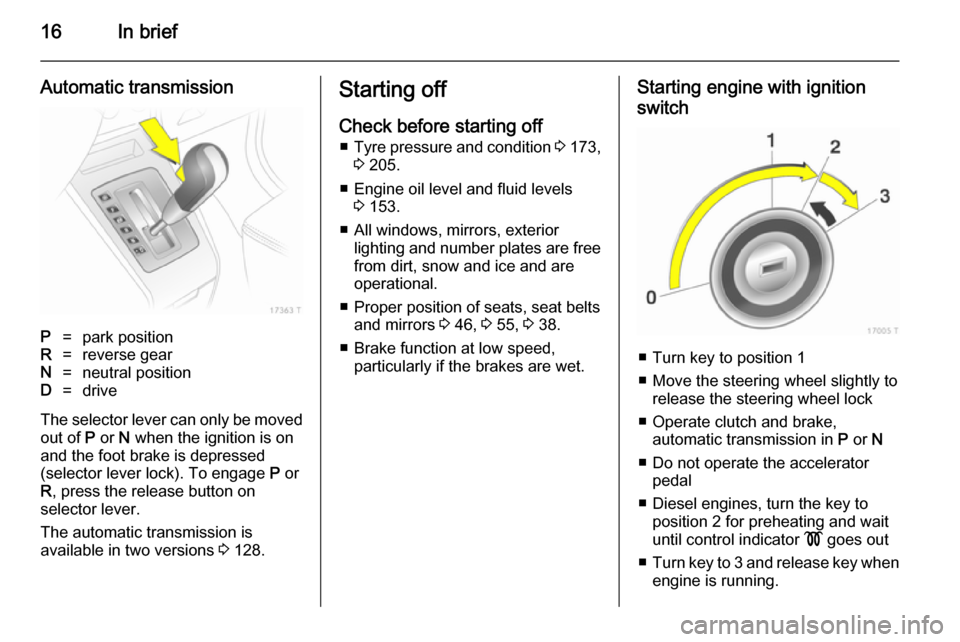
16In brief
Automatic transmissionP=park positionR=reverse gearN=neutral positionD=drive
The selector lever can only be movedout of P or N when the ignition is on
and the foot brake is depressed
(selector lever lock). To engage P or
R , press the release button on
selector lever.
The automatic transmission is
available in two versions 3 128.
Starting off
Check before starting off ■ Tyre pressure and condition 3 173,
3 205.
■ Engine oil level and fluid levels 3 153.
■ All windows, mirrors, exterior lighting and number plates are free
from dirt, snow and ice and are
operational.
■ Proper position of seats, seat belts and mirrors 3 46, 3 55, 3 38.
■ Brake function at low speed, particularly if the brakes are wet.Starting engine with ignition
switch
■ Turn key to position 1
■ Move the steering wheel slightly to release the steering wheel lock
■ Operate clutch and brake, automatic transmission in P or N
■ Do not operate the accelerator pedal
■ Diesel engines, turn the key to position 2 for preheating and wait
until control indicator ! goes out
■ Turn key to 3 and release key when
engine is running.
Page 19 of 217
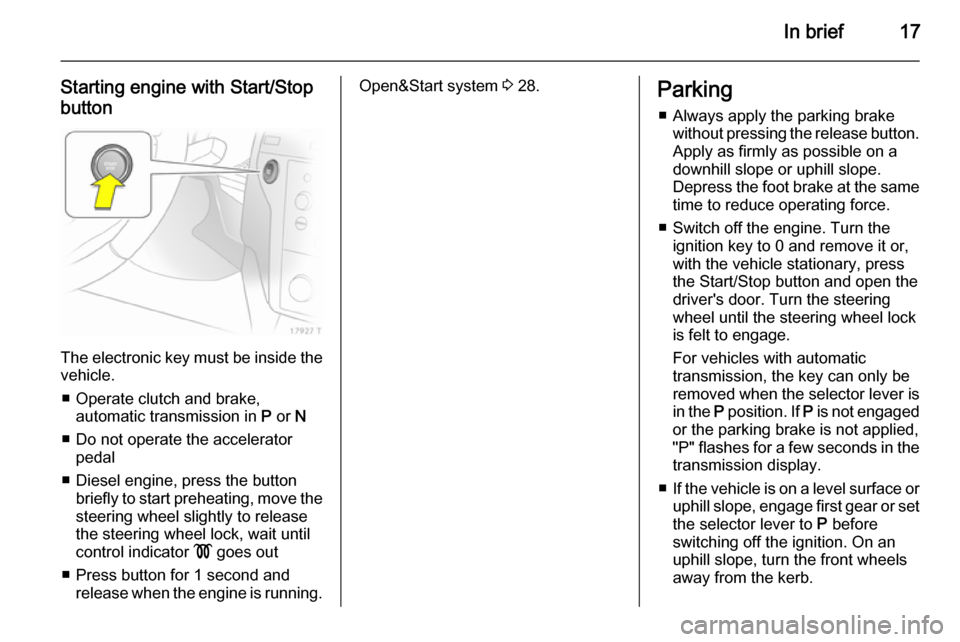
In brief17
Starting engine with Start/Stop
button
The electronic key must be inside the
vehicle.
■ Operate clutch and brake, automatic transmission in P or N
■ Do not operate the accelerator pedal
■ Diesel engine, press the button briefly to start preheating, move thesteering wheel slightly to release
the steering wheel lock, wait until
control indicator ! goes out
■ Press button for 1 second and release when the engine is running.
Open&Start system 3 28.Parking
■ Always apply the parking brake without pressing the release button.Apply as firmly as possible on a
downhill slope or uphill slope.
Depress the foot brake at the same
time to reduce operating force.
■ Switch off the engine. Turn the ignition key to 0 and remove it or,
with the vehicle stationary, press
the Start/Stop button and open the
driver's door. Turn the steering
wheel until the steering wheel lock
is felt to engage.
For vehicles with automatic
transmission, the key can only be
removed when the selector lever is in the P position. If P is not engaged
or the parking brake is not applied,
"P" flashes for a few seconds in the transmission display.
■ If the vehicle is on a level surface or
uphill slope, engage first gear or set the selector lever to P before
switching off the ignition. On an
uphill slope, turn the front wheels
away from the kerb.
Page 25 of 217
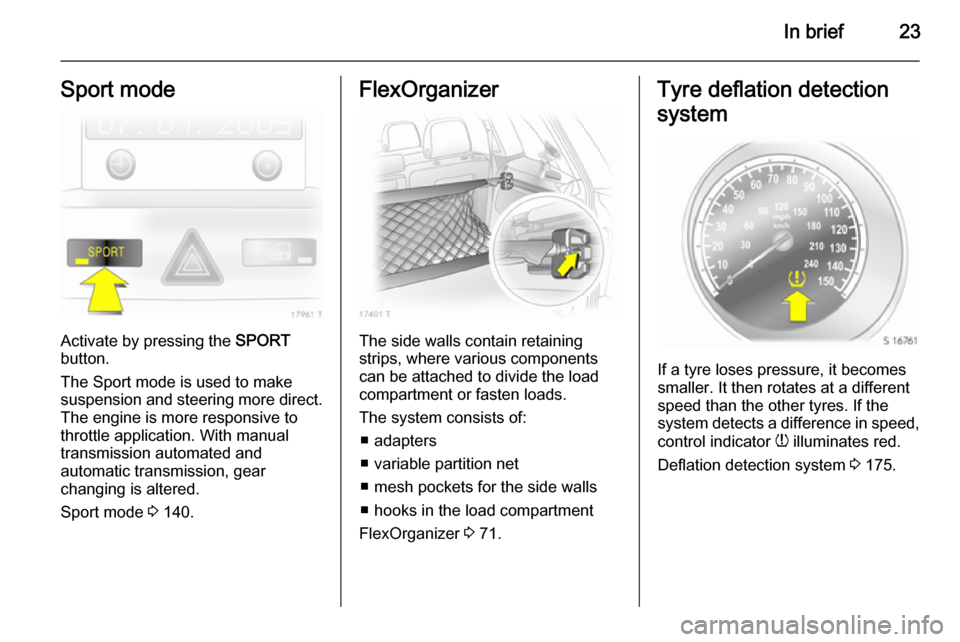
In brief23Sport mode
Activate by pressing the SPORT
button.
The Sport mode is used to make
suspension and steering more direct.
The engine is more responsive to
throttle application. With manual
transmission automated and
automatic transmission, gear
changing is altered.
Sport mode 3 140.
FlexOrganizer
The side walls contain retaining
strips, where various components can be attached to divide the load
compartment or fasten loads.
The system consists of: ■ adapters
■ variable partition net
■ mesh pockets for the side walls
■ hooks in the load compartment
FlexOrganizer 3 71.
Tyre deflation detection
system
If a tyre loses pressure, it becomes
smaller. It then rotates at a different speed than the other tyres. If the
system detects a difference in speed,
control indicator w illuminates red.
Deflation detection system 3 175.
Page 26 of 217
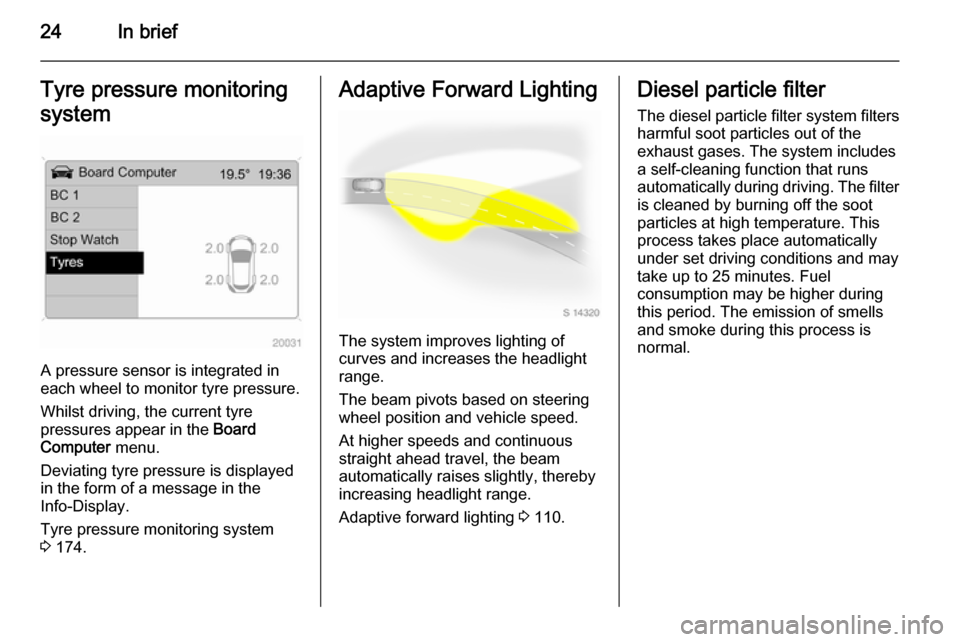
24In briefTyre pressure monitoring
system
A pressure sensor is integrated in
each wheel to monitor tyre pressure.
Whilst driving, the current tyre
pressures appear in the Board
Computer menu.
Deviating tyre pressure is displayed
in the form of a message in the
Info-Display.
Tyre pressure monitoring system
3 174.
Adaptive Forward Lighting
The system improves lighting of
curves and increases the headlight
range.
The beam pivots based on steering
wheel position and vehicle speed.
At higher speeds and continuous straight ahead travel, the beam
automatically raises slightly, thereby
increasing headlight range.
Adaptive forward lighting 3 110.
Diesel particle filter
The diesel particle filter system filters
harmful soot particles out of the
exhaust gases. The system includes
a self-cleaning function that runs
automatically during driving. The filter
is cleaned by burning off the soot
particles at high temperature. This
process takes place automatically
under set driving conditions and may take up to 25 minutes. Fuel
consumption may be higher during
this period. The emission of smells
and smoke during this process is
normal.
Page 30 of 217
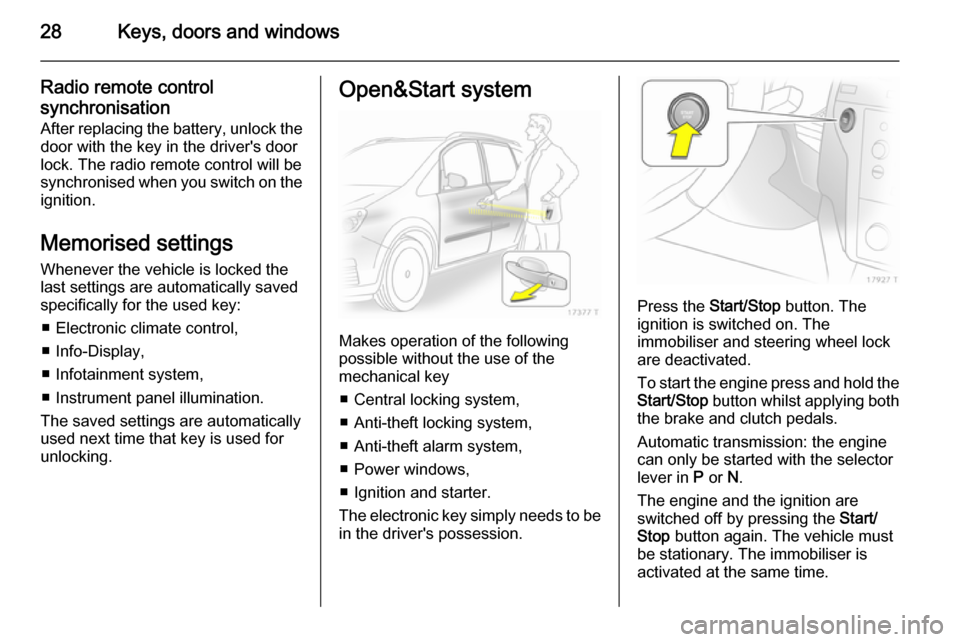
28Keys, doors and windows
Radio remote controlsynchronisation
After replacing the battery, unlock the
door with the key in the driver's door
lock. The radio remote control will be
synchronised when you switch on the
ignition.
Memorised settings Whenever the vehicle is locked the
last settings are automatically saved
specifically for the used key:
■ Electronic climate control,
■ Info-Display,
■ Infotainment system,
■ Instrument panel illumination.
The saved settings are automatically used next time that key is used for
unlocking.Open&Start system
Makes operation of the following
possible without the use of the
mechanical key
■ Central locking system,
■ Anti-theft locking system,
■ Anti-theft alarm system,
■ Power windows,
■ Ignition and starter.
The electronic key simply needs to be in the driver's possession.
Press the Start/Stop button. The
ignition is switched on. The
immobiliser and steering wheel lock
are deactivated.
To start the engine press and hold the
Start/Stop button whilst applying both
the brake and clutch pedals.
Automatic transmission: the engine
can only be started with the selector
lever in P or N.
The engine and the ignition are
switched off by pressing the Start/
Stop button again. The vehicle must
be stationary. The immobiliser is
activated at the same time.
Page 31 of 217
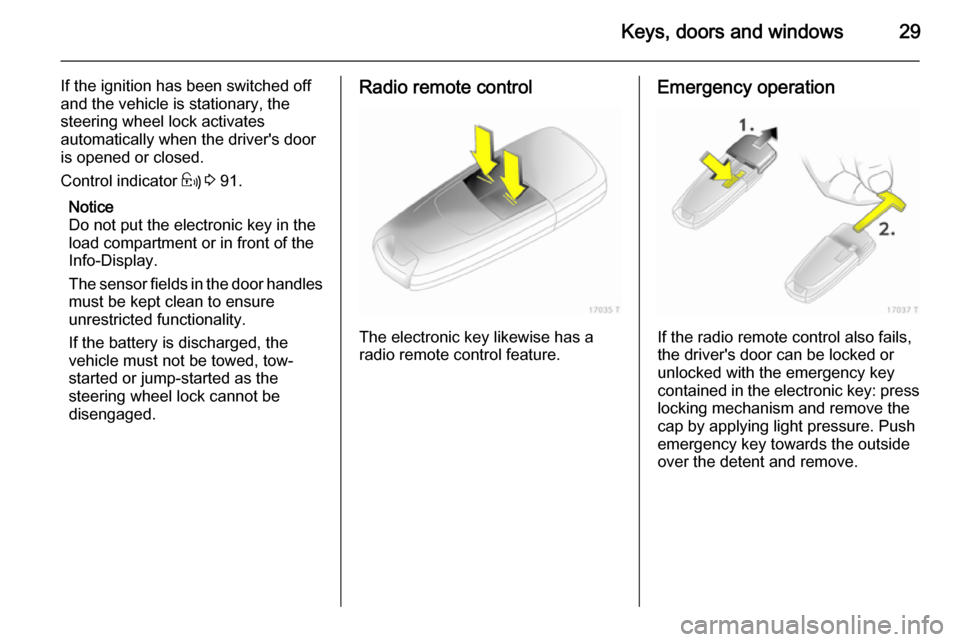
Keys, doors and windows29
If the ignition has been switched off
and the vehicle is stationary, the
steering wheel lock activates
automatically when the driver's door
is opened or closed.
Control indicator 0 3 91.
Notice
Do not put the electronic key in the
load compartment or in front of the
Info-Display.
The sensor fields in the door handles
must be kept clean to ensure
unrestricted functionality.
If the battery is discharged, the
vehicle must not be towed, tow-
started or jump-started as the
steering wheel lock cannot be
disengaged.Radio remote control
The electronic key likewise has a
radio remote control feature.
Emergency operation
If the radio remote control also fails,
the driver's door can be locked or
unlocked with the emergency key
contained in the electronic key: press locking mechanism and remove the
cap by applying light pressure. Push
emergency key towards the outside
over the detent and remove.
Page 48 of 217
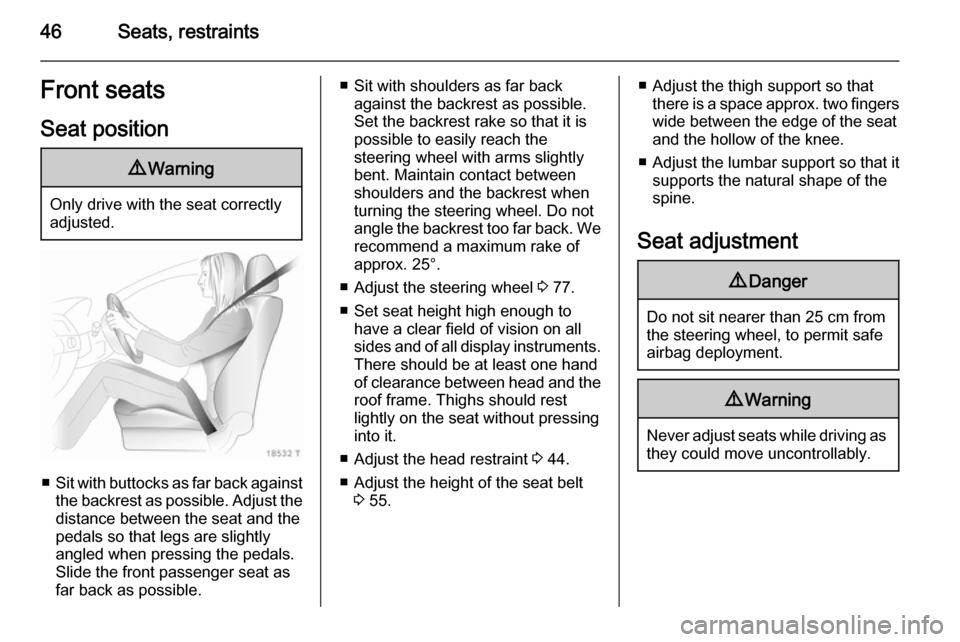
46Seats, restraintsFront seatsSeat position9 Warning
Only drive with the seat correctly
adjusted.
■ Sit with buttocks as far back against
the backrest as possible. Adjust the distance between the seat and the
pedals so that legs are slightly
angled when pressing the pedals.
Slide the front passenger seat as
far back as possible.
■ Sit with shoulders as far back against the backrest as possible.
Set the backrest rake so that it is possible to easily reach the
steering wheel with arms slightly bent. Maintain contact between
shoulders and the backrest when
turning the steering wheel. Do not
angle the backrest too far back. We recommend a maximum rake of
approx. 25°.
■ Adjust the steering wheel 3 77.
■ Set seat height high enough to have a clear field of vision on allsides and of all display instruments.
There should be at least one hand
of clearance between head and the
roof frame. Thighs should rest
lightly on the seat without pressing
into it.
■ Adjust the head restraint 3 44.
■ Adjust the height of the seat belt 3 55.■ Adjust the thigh support so that
there is a space approx. two fingers
wide between the edge of the seat
and the hollow of the knee.
■ Adjust the lumbar support so that it
supports the natural shape of the
spine.
Seat adjustment9 Danger
Do not sit nearer than 25 cm from
the steering wheel, to permit safe
airbag deployment.
9 Warning
Never adjust seats while driving as
they could move uncontrollably.